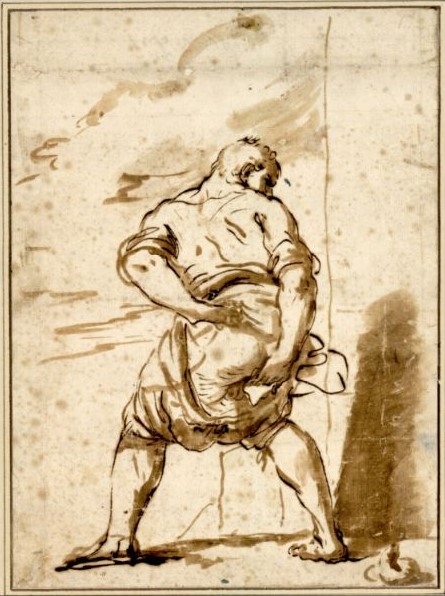|
Asher Yatzar
Asher yatzar ( he, בִּרְכַּת אֲשֶׁר יָצַר "Who has formed man") is a blessing in Judaism. It is recited after engaging in an act of excretion or urination, but is also included in many Jewish prayer books as a part of daily prayer prior to ''birkot hashachar''. The purpose of this blessing is to thank God for good health. It expresses thanks for having the ability to excrete, for without it existence would be impossible. Though recited normally by observant Jews each time excretory functions are used, it is also recited during the Shacharit service due to its spiritual significance (to Jews, humans are made in God's image, so it is an expression of awe toward God's creations). Sources The obligation to recite a blessing upon leaving the bathroom could be traced to the following passage in Berachot (60b): Abaye objects to saying the above, and suggests one should recite something else prior to relieving oneself as well as recite a blessing similar to ''Asher ... [...More Info...] [...Related Items...] OR: [Wikipedia] [Google] [Baidu] |
Defecation
Defecation (or defaecation) follows digestion, and is a necessary process by which organisms eliminate a solid, semisolid, or liquid waste material known as feces from the digestive tract via the anus. The act has a variety of names ranging from the common, like pooping or crapping, to the technical, e.g. bowel movement, to the obscene ('' shitting''), to the euphemistic ("dropping a deuce" or "taking a dump"). The topic, usually avoided among polite company, can become the basis for some potty humour. Humans expel feces with a frequency varying from a few times daily to a few times weekly. Waves of muscular contraction (known as '' peristalsis'') in the walls of the colon move fecal matter through the digestive tract towards the rectum. Undigested food may also be expelled this way, in a process called ''egestion''. When birds defecate, they also expel urine and urates in the same mass, whereas other animals may also urinate at the same time, but spatially separat ... [...More Info...] [...Related Items...] OR: [Wikipedia] [Google] [Baidu] |
Jewish Blessings
Listed below are some Hebrew prayers and blessings that are part of Judaism that are recited by many Jews. Most prayers and blessings can be found in the Siddur, or prayer book. This article addresses Jewish liturgical blessings, which generally begin with the formula: Transliteration: ' Translation: "Blessed are You, our God, King of the universe..." Pronunciation In the transliterations below, ' is used to refer to the sh'vah, which is similar/equivalent to ə; a mid-word aleph, a glottal stop; and a mid-word ayin, a voiced pharyngeal fricative ʕ similar/equivalent to Arabic . Whenever ''`'' is used, it refers to ayin whether word-initial, medial, or final. 'H/h' are used to represent both he, an English h sound as in "hat"; and ḥes, a voiceless pharyngeal fricative ħ equivalent to Arabic . Whenever 'ḥ' is used, it refers to ḥet. Resh is represented by an 'r,' though it's equivalent to Spanish 'r,' Spanish 'rr,' or French 'r,' depending on one's dialec ... [...More Info...] [...Related Items...] OR: [Wikipedia] [Google] [Baidu] |
Jewish Prayer And Ritual Texts
Jews ( he, יְהוּדִים, , ) or Jewish people are an ethnoreligious group and nation originating from the Israelites Israelite origins and kingdom: "The first act in the long drama of Jewish history is the age of the Israelites""The people of the Kingdom of Israel and the ethnic and religious group known as the Jewish people that descended from them have been subjected to a number of forced migrations in their history" and Hebrews of historical Israel and Judah. Jewish ethnicity, nationhood, and religion are strongly interrelated, "Historically, the religious and ethnic dimensions of Jewish identity have been closely interwoven. In fact, so closely bound are they, that the traditional Jewish lexicon hardly distinguishes between the two concepts. Jewish religious practice, by definition, was observed exclusively by the Jewish people, and notions of Jewish peoplehood, nation, and community were suffused with faith in the Jewish God, the practice of Jewish (religious) l ... [...More Info...] [...Related Items...] OR: [Wikipedia] [Google] [Baidu] |
Excretion
Excretion is a process in which metabolic waste is eliminated from an organism. In vertebrates this is primarily carried out by the lungs, kidneys, and skin. This is in contrast with secretion, where the substance may have specific tasks after leaving the cell. Excretion is an essential process in all forms of life. For example, in mammals, urine is expelled through the urethra, which is part of the excretory system. In unicellular organisms, waste products are discharged directly through the surface of the cell. During life activities such as cellular respiration, several chemical reactions take place in the body. These are known as metabolism. These chemical reactions produce waste products such as carbon dioxide, water, salts, urea and uric acid. Accumulation of these wastes beyond a level inside the body is harmful to the body. The excretory organs remove these wastes. This process of removal of metabolic waste from the body is known as excretion. Green plants ... [...More Info...] [...Related Items...] OR: [Wikipedia] [Google] [Baidu] |
List Of Jewish Prayers
Listed below are some Hebrew prayers and blessings that are part of Judaism that are recited by many Jews. Most prayers and blessings can be found in the Siddur, or prayer book. This article addresses Jewish liturgical blessings, which generally begin with the formula: Transliteration: ' Translation: "Blessed are You, our God, King of the universe..." Pronunciation In the transliterations below, ' is used to refer to the sh'vah, which is similar/equivalent to ə; a mid-word aleph, a glottal stop; and a mid-word ayin, a voiced pharyngeal fricative ʕ similar/equivalent to Arabic . Whenever ''`'' is used, it refers to ayin whether word-initial, medial, or final. 'H/h' are used to represent both he, an English h sound as in "hat"; and ḥes, a voiceless pharyngeal fricative ħ equivalent to Arabic . Whenever 'ḥ' is used, it refers to ḥet. Resh is represented by an 'r,' though it's equivalent to Spanish 'r,' Spanish 'rr,' or French 'r,' depending on one's dialect. In al ... [...More Info...] [...Related Items...] OR: [Wikipedia] [Google] [Baidu] |
Laxative
Laxatives, purgatives, or aperients are substances that loosen stools and increase bowel movements. They are used to treat and prevent constipation. Laxatives vary as to how they work and the side effects they may have. Certain stimulant, lubricant and saline laxatives are used to evacuate the colon for rectal and bowel examinations, and may be supplemented by enemas under certain circumstances. Sufficiently high doses of laxatives may cause diarrhea. Some laxatives combine more than one active ingredient. Laxatives may be administered orally or rectally. Types Bulk-forming agents Bulk-forming laxatives, also known as roughage, are substances, such as fiber in food and hydrophilic agents in over-the-counter drugs, that add bulk and water to stools so that they can pass more easily through the intestines (lower part of the digestive tract). Properties * Site of action: small and large intestines * Onset of action: 12–72 hours * Examples: dietary fiber, Metamuc ... [...More Info...] [...Related Items...] OR: [Wikipedia] [Google] [Baidu] |
Diarrhea
Diarrhea, also spelled diarrhoea, is the condition of having at least three loose, liquid, or watery bowel movements each day. It often lasts for a few days and can result in dehydration due to fluid loss. Signs of dehydration often begin with loss of the normal stretchiness of the skin and irritable behaviour. This can progress to decreased urination, loss of skin color, a fast heart rate, and a decrease in responsiveness as it becomes more severe. Loose but non-watery stools in babies who are exclusively breastfed, however, are normal. The most common cause is an infection of the intestines due to either a virus, bacterium, or parasite—a condition also known as gastroenteritis. These infections are often acquired from food or water that has been contaminated by feces, or directly from another person who is infected. The three types of diarrhea are: short duration watery diarrhea, short duration bloody diarrhea, and persistent diarrhea (lasting more than two wee ... [...More Info...] [...Related Items...] OR: [Wikipedia] [Google] [Baidu] |
Foley Catheter
In urology, a Foley catheter (named for Frederic Foley, who produced the original design in 1929) is a flexible tube that a clinician passes through the urethra and into the bladder to drain urine. It is the most common type of indwelling urinary catheter. The tube has two separated channels, or ''lumens'', running down its length. One lumen, open at both ends, drains urine into a collection bag. The other has a valve on the outside end and connects to a balloon at the inside tip. The balloon is inflated with sterile water when it lies inside the bladder to stop it from slipping out. Manufacturers usually produce Foley catheters using silicone or coated natural latex. Coatings include polytetrafluoroethylene, hydrogel, or a silicon elastomer – the different properties of these surface coatings determine whether the catheter is suitable for 28-day or 3-month indwelling duration. Foley catheters should be used only when indicated, as use increases the risk of catheter-asso ... [...More Info...] [...Related Items...] OR: [Wikipedia] [Google] [Baidu] |
Urinary Incontinence
Urinary incontinence (UI), also known as involuntary urination, is any uncontrolled leakage of urine. It is a common and distressing problem, which may have a large impact on quality of life. It has been identified as an important issue in geriatric health care. The term enuresis is often used to refer to urinary incontinence primarily in children, such as nocturnal enuresis (bed wetting). UI is an example of a stigmatized medical condition, which creates barriers to successful management and makes the problem worse. People may be too embarrassed to seek medical help, and attempt to self-manage the symptom in secrecy from others. Pelvic surgery, pregnancy, childbirth, and menopause are major risk factors. Urinary incontinence is often a result of an underlying medical condition but is under-reported to medical practitioners. There are four main types of incontinence: * Urge incontinence due to an overactive bladder * Stress incontinence due to "a poorly functioning urethral ... [...More Info...] [...Related Items...] OR: [Wikipedia] [Google] [Baidu] |
Ritual Washing In Judaism
In Judaism, ritual washing, or ablution, takes two main forms. ''Tevilah'' (טְבִילָה) is a full body immersion in a mikveh, and ''netilat yadayim'' is the washing of the hands with a cup (see Handwashing in Judaism). References to ritual washing are found in the Hebrew Bible, and are elaborated in the Mishnah and Talmud. They have been codified in various codes of Jewish law and tradition, such as Maimonides' ''Mishneh Torah'' (12th century) and Joseph Karo's ''Shulchan Aruch'' (16th century). These practices are most commonly observed within Orthodox Judaism. In Conservative Judaism, the practices are normative, with certain leniencies and exceptions. Ritual washing is not generally performed in Reform Judaism. Hebrew Bible The Hebrew Bible requires immersion of the body in water as a means of purification in several circumstances, for example: : And when the ''zav'' is cleansed of his issue, then he shall number to himself seven days for his cleansing, and wash hi ... [...More Info...] [...Related Items...] OR: [Wikipedia] [Google] [Baidu] |
Halakha
''Halakha'' (; he, הֲלָכָה, ), also transliterated as ''halacha'', ''halakhah'', and ''halocho'' ( ), is the collective body of Jewish religious laws which is derived from the written and Oral Torah. Halakha is based on biblical commandments ('' mitzvot''), subsequent Talmudic and rabbinic laws, and the customs and traditions which were compiled in the many books such as the ''Shulchan Aruch''. ''Halakha'' is often translated as "Jewish law", although a more literal translation of it might be "the way to behave" or "the way of walking". The word is derived from the root which means "to behave" (also "to go" or "to walk"). ''Halakha'' not only guides religious practices and beliefs, it also guides numerous aspects of day-to-day life. Historically, in the Jewish diaspora, ''halakha'' served many Jewish communities as an enforceable avenue of law – both civil and religious, since no differentiation of them exists in classical Judaism. Since the Jewish Enlightenment ... [...More Info...] [...Related Items...] OR: [Wikipedia] [Google] [Baidu] |



